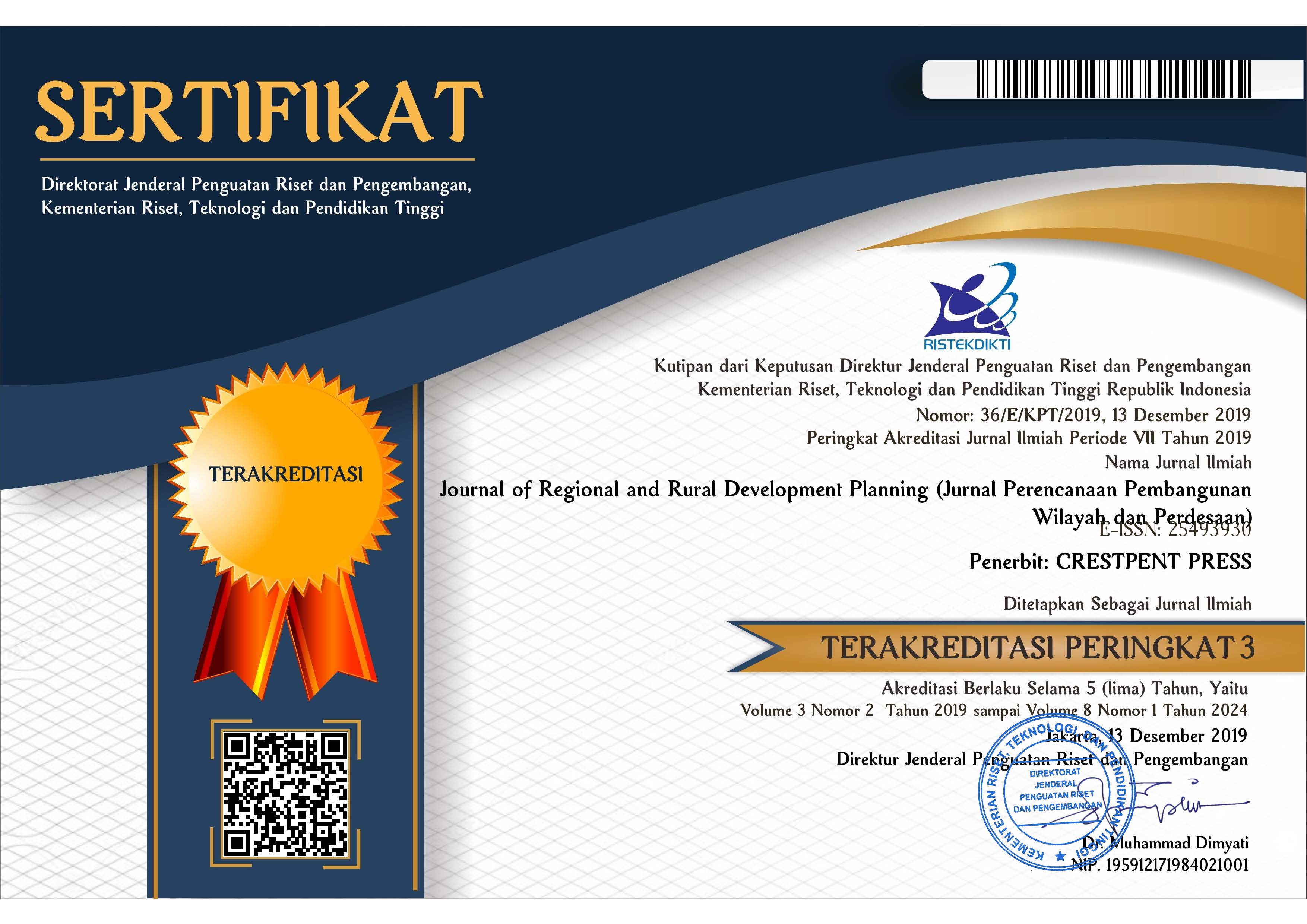The Role of Terraced Paddy Fields and Its Critical Issues in Sustaining a Mountainous Tropical Monsoon Rural Community: Case Study of Malasari Village, Bogor Regency, Indonesia
Abstract
Terraced paddy fields play an important role not only in the food production function, but also in flooding control, water source recharge, and soil erosion and landslide prevention in mountainous area. Abandonment has been occurring in many countries due to natural condition climate, low-productive, less economic condition, depopulation, aging, and poor work efficiency. However, the terraced fields in Malasari village, Bogor Regency are relatively sustained and constantly maintained by traditional local farmers. Therefore, this study aims to seek keys to how to maintain of the terraced paddy fields by local farmers in Malasari village. The survey was conducted from October 2019 to January 2020 on Malasari village (6°40’S and 106°31’E) by using primary and secondary data with a sample of 28 households. Questionnaire survey was conducted to elicit primary data on farmer’s basic information. Verification of land cover in Malasari village was carried out by visual interpretation land cover in images obtained from drone image in 2019. The terraced paddy fields have been maintained by local farmers contentiously. Two factors are discovered maintained the terraced paddy fields, namely: (1) the local wisdom technique is an act that has direct influences on the physical structure of terraced paddy fields for maintaining, especially land management which is plowing and making levee are playing an important role, and (2) social capital is an act that has indirect influences on the terraced paddy fields. These factors interact with each other to maintain the terraced paddy fields.
References
Adachi, S. (2007). Agricultural Technologies of Terraced Rice Cultivation in the Ailao Mountains, Yunnan, China. Asian and African Area Studies, 6 (2), 173-196.
Amien, I., Rejekiningrum, P., Pramudia, A., & Susanti, E. (1996). Effects of inter annual climate variability and climate change on rice yield in Java, Indonesia. Water, Air, and Soil Pollution, 92, 29–39.
Arnáez, J., Lana-Renault, N., Lasanta, T., Ruiz-Flaño, P., & Castroviejo, J. (2015). Effects of farming terraces on hydrological and geomorphological processes. A review. CATENA, 128, 122-134.
Cao, S., Chen, L., Feng, Q., & Liu, Z. (2007). Soft-riser bench terrace design for the hilly loess region of Shaanxi Province, China. Landscape and Urban Planning, 80 (1-2), 184–191.
Center for Topographic Information. (2007). Mapping Information: Topo Maps: Frequently Asked Questions. Natural Resources Canada. http://maps.nrcan.gc.ca/topo101/faq_e.php Accessed 4 March 2020
Dahal, G, R. & Krishna, P, A. (2008). Bridging, Linking and Bonding Social Capital in Collective Action, The Case of Kalahan Forest Reserve in the Philippines. CAPRi Working Paper (79), 10–11.
Fukamachi, K., Hirokazu, O., & Aiko, M. (2005). The relationships between the structure of paddy levees and the plant species diversity in cultural landscapes on the west side of Lake Biwa, Shiga, Japan, Landscape Ecol Eng. (1), 191–199.
Geertz, C. (1963). Agricultural Involution: The Processes of Ecological Change in Indonesia: University of California Press, Berkeley and Los Angeles.
Harashina, K., Takeuchi, K., & Arifin, H, S. (2002). Toward Restructuring of sustainable Regional Ecosystems in Humid Tropics (in Japanese).
Iskandar, J. & Iskandar, B. (2011). Agroecosystem of Sundanese People. PT Kiblat Buku Utama, Bandung. (in Indonesian)
Iskandar, J., Iskandar, B. S., & Partasasmita, R. (2018). The impact of social and economic change on domesticated plant diversity with special reference to wet rice field and home-garden farming of West Java, Indonesia. Biodiversitas Journal of Biological Diversity 19 (2), 515-527
Maltby, E., Holdgate, M., Aceman, M. C., & Weir, A. (1999). Ecosystem Management: Questions for Science and Society. Sibthorp Trust; 1999.
Masumoto, T. (2004). Multi-functional Roles of Paddy Irrigation in Monsoon Asia. Journal of the Japan Society of Civil Engineers (72-7), 11-16
Montgomery, D. R. (2007). Dirt: The erosion of civilizations. University of California Press, Ltd., London, 285
Nakajima M. (1996). Sustainability of rice terraces. J. Geogr. 105; 547e568
Nugroho, K., Slamet, S., & Lestari, P. (2017). Genetic diversity of 24 rice varieties of sawah and gogo (Oriza sativa L) of Indonesia based on Marka SSR. Scripta Biologica 4 (1), 5-10. [Indonesian]
Pelzer, K. J. (1948). Pioneer Settlement in the Asiatic Tropics. American Geographical Society, New York.
Posthumus, H., & Stroosnijder, L. (2010). To terrace or not: the short-term impact of bench terraces on soil properties and crop response in the Peruvian Andes. Environ. Dev. Sustain. (12), 263–276
Pravitasari, A. E., Rustiadi, E., Mulya, S. P., Setiawan, Y., Fuadina, L. N., & Murtadho, A. (2018). Identifying the driving forces of urban expansion and its environmental impact in Jakarta-Bandung mega urban region. IOP Conf. Series: Earth and Environmental Science. 149.
Puspita, L., Ratnawati, E., Suryadiputra, I. N. N., & Meutia, A. A. (2005). Man-made Wet Land of Indonesia. Wetlands International-Indonesia Programme, Bogor. (in Indonesian)
Redfern, S, K., Azzu, N., &. Binamira, J, S. (2012). Rice in Southeast Asia: Facing Risks and Vulnerabilities to Respond to Climate Change.
Robert, D, P. (1993) The Prosperous Community: Social Capital and Public Life. American Prospect, 13 (4), 35–43.
Sastrapradja, S. D. & Widjaja, E. A. (2010). Biodiversity of Agriculture Guarantees Food Sovereignty. LIPI Press, Jakarta. (in Indonesian)
Sedana, G., Ambarawati, I., & Windia W. (2014). Strengthening social capital for agricultural development: lessons from Guama, Bali, Indonesia
Shrestra, D. P., Zinck, J. A., & Van, R. E. (2004). Modeling land degradation in the Nepalese Himalaya. Catena (57), 135–156
Sundquist, B. (2007). Urbanization-caused topsoil (cropland) loss. In The earth’s carrying capacity, some literature reviews and analyses
Tanoi, M. (2007). Social Capital and Agriculture/Rural Development Policy. Journal of the Agricultural and Rural Workers' Association (10), 911-914, (in Japanse)
Woolcock, M. & Narayan, D., (2000). Social Capital: Implication for Development Theory, Research, and Policy. World Bank Research and Observer, 15 (2), 225 – 249. World Bank 2019, Available online: https://data.worldbank.org/indicator/SP.POP.TOTL?locations=ID (assessed on 19 November 2020).
Yamanaka, H., Sawada, T., Kozuki, Y., Kamada, M., Ishida, K., & Yamaguchi, Y., (2000). An analysis of rice-terrace conservation strategy based on the Project-Cycle-Management method. Environment System Research (28), 255-266.
Yamani, A., Rustiadi, E., & Widiatmaka, W., (2015). Evaluasi pola ruang berbasis kerawanan banjir di Kabupaten Pidie. Tata Loka, 17 (3), 130-1. (in Indonesian)
Copyright (c) 2021 Journal of Regional and Rural Development Planning (Jurnal Perencanaan Pembangunan Wilayah dan Perdesaan)

This work is licensed under a Creative Commons Attribution-ShareAlike 4.0 International License.




.png)














